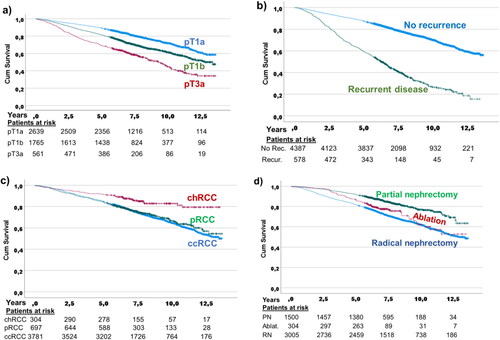Figures & data
Table 1. The distribution of patient’s characteristics in relation to renal cell carcinoma (RCC) type, of 4,965 patients with cT1 RCC extracted from the National Swedish Kidney Cancer Register, years 2005–2014.
Table 2. Recurrent disease in relation to tumor size and to the performed treatment shown in 4,965 patients with cT1M0 renal cell carcinoma.
Table 3. Distribution of sites of disease recurrence in relation to histological tumor type in 578 patients among the 4,965 patients with cT1M0 renal cell carcinoma at primary diagnosis.
Table 4. Distribution of survival status in relation to RCC type, pT stage, occurrence of recurrent disease and survival in 4,965 patients with cT1 renal cell carcinoma.
Table 5. Results for Cox regression analysis of factors important for time to recurrent disease in 4,965 patients with non-metastatic cT1 renal cell carcinoma.
Figure 1. Kaplan-Meier curves of univariate overall survival probability in relation to (a) T stage, pT1a, versus pT1b versus pT3a, (p < 0.001 for all pair-wise differences), (b) patients with recurrent disease versus no recurrence (p < 0.001), (c) RCC types (p < 0.001 for chromophobe RCC versus papillary RCC versus clear cell RCC), and (d) treatment with partial nephrectomy, ablative treatment, and radical nephrectomy (p < 0.001 for partial nephrectomy versus ablation, and versus radical nephrectomy, respectively). Number of patients at risk are shown below corresponding time points.

Table 6. Results from Cox regression analysis of factors important for overall survival in 4,965 patients with non-metastatic cT1 renal cell carcinoma, adjusted for age, gender, tumor size, RCC type, pT-stage, given treatment, recurrence status and N-stage.
